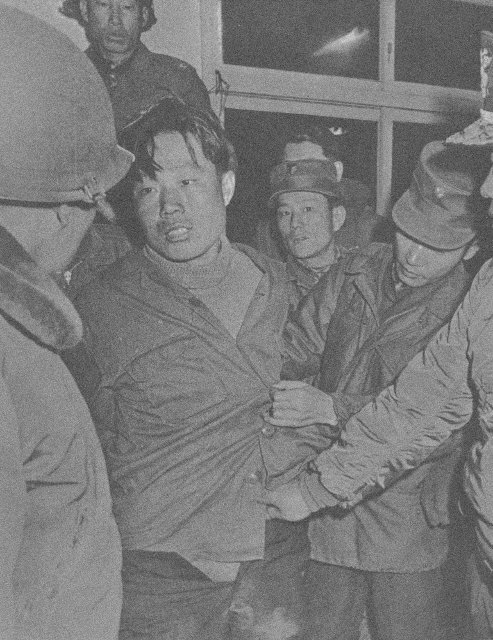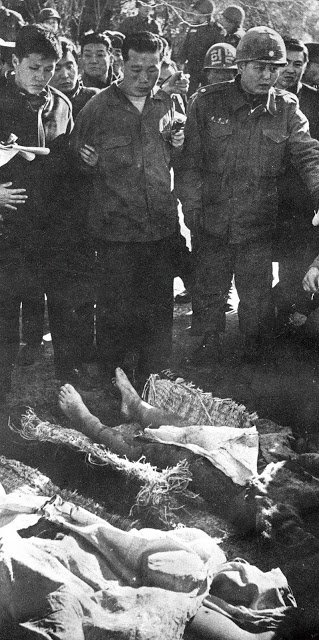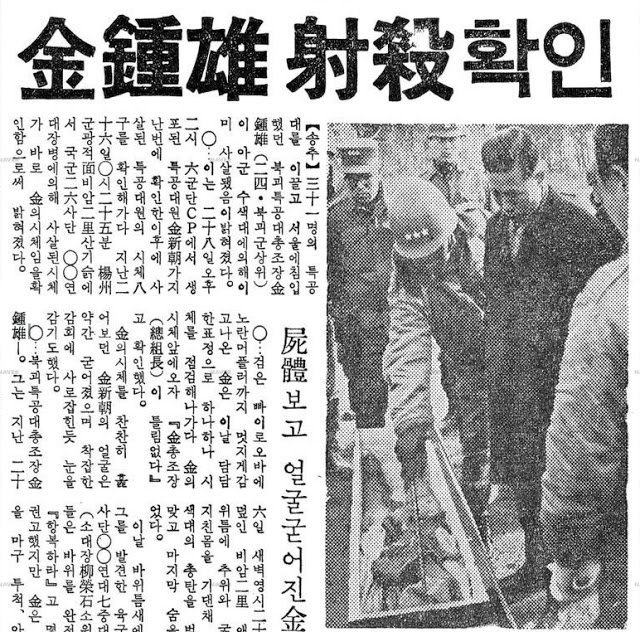Precursor to the Mỹ Lai Massacre: 1968 Phong Nhị, Phong Nhất_#7
Chapter 7: Kim Shin-jo and the Darkness that was ROK

Kim Shin-jo, after being captured by the ROK Military Police. Unlike the other members of the North Korean Armed Special Forces, he did not opt for resistance or suicide bombing, but rather opted for survival. Thereafter, he was given the role of propagating the superiority of the South Korean system. He even became a pastor of the Christian faith. Photograph: 『1969 Almanac of News Photos』.
Kim Shin-jo raised his hand.
It was in the afternoon of January 19, 1968. The sun was ready to set for the day. It was time to leave. Strong gusts of wind came blowing like blades. The temperature was at a record low of -10℃, but the wind chill temperature felt actually more like -20℃. He had to hurry up and make up his mind. To kill or spare? The foot of Sambong-san (mountain range in Paju-gun, Gyeonggi Province) was covered in snow. The North Korean Special Forces, who had arrived at 5:00 am that day and were resting in the encampment that they had set up in the southern ridge, were voting by a show of hands. The fates of four woodcutter brothers, Woo Hee-je (30), Woo Kyung-je (23), Woo Chul-je (21), and Woo Sung-je (20) were at their disposal. Kim Shin-jo (26), from Chongjin, North Hamgyong Province, second lieutenant of the DPRK National Defense Reconnaissance Office, and commander of Unit 124, Base 6, Group 2, raised his hand. He voted in favor of killing all four.
It had only been three days Since they departed from their Unit 124 base in Yeonsan-gun, North Hwanghae Province. Wireless contact with the superior office had been cut off. The majority voted on keeping the four brothers alive, as there was no one willing to shovel the frozen earth to bury them. Some insisted that it would be cruel to kill the poor and marginalized when the North was in fact stirring up a revolution for the sake of the laborers and farmers in the South. Only a few voted on actually killing them as they were instructed prior to embarking on their mission. Kim Shin-jo didn’t get his way. They left the four brothers there, according to majority rule, and went on their ways.
Kim Shin-jo raised both hands.
It was daybreak on January 22, 1968. The temperature in Seoul was numbing to the bones, as it was supposed to snow according to forecasts. He had to make up his mind. To die or to be spared? He was hiding behind the rocks of a small valley in Segumjung, Hongje-dong, Eunpyeong-gu. A flash of light shone past his face, followed by a voice on a loudspeaker saying, “We’ll spare your life if you surrender and come out.” His finger was fixed on the firing pin of his hand grenade. He had been instructed to opt for suicide bombing in such a situation. Again he heard the enticing voice on the loudspeaker urging, “You can trust us. We’ll spare your life. Just come out in the open.” Kim Shin-jo raised both hands as he slowly made his way out.
He wanted to live. He stood at a crossroads, thinking about his remaining life that he would not be able to live. He was arrested by military personnel who handed him off to headquarters of the army espionage prevention unit in Hyoja-dong, Jongno-gu, Seoul. “We came to behead Park Chung-hee,” he boldly announced to reporters at the unit cafeteria that evening. He spent the night there. In the afternoon of the next day, January 23, he heard the frightening news of the U.S. intelligence ship, USS Pueblo, being captured by the North Korean navy in the East Sea. More than 80 crewmembers were also kidnapped by North Korea.
Kim Shin-jo clenched his teeth.
It was January 28, 1968 at the ROK VI Corps Command Headquarters, located in Songchu, Yangju-gun, Gyeonggi Province. Kim Shin-jo, neatly dressed in a black overcoat and yellow scarf, stood in front of the corpse. Lieutenant General, Lee Se-ho, head of the VI Corps, pointed at the face of the corpse with his baton. Kim Shin-jo could have easily passed for a high-ranking government official on a site investigation. It hadn’t yet been a full hour since he was at the interrogation room of the Counterintelligence Corps, wearing his prison uniform. He was relocated to the smaller entity in Seobinggo from the Counterintelligence Corps Headquarters in Hyoja-dong. He verified and confirmed that the corps was Kim Jong-woong (24), overall commander of the DPRK 124 Corps, base 6.

January 25, 1968, at the ROK VI Corps Command Headquarters, located in Songchu, Yangju-gun, Gyeonggi Province, Kim Shin-jo verifying the faces of the dead North Korean Special Forces. He has his hands tied back and is wearing a military top with black pants. Photograph: 『1969 Almanac of News Photos』.
Kim Jong-woong, who had infiltrated Seoul to invade the Blue House along with Kim Shin-jo, decided on a different route. On January 26 at daybreak, while throwing hand grenades in resistance through the crevices between the snow-covered boulders of Aeri-su, Bi-am 2 ri, Gwangjeok-myeon, Yangju-gun, he was shot twice in the chest, once in his shoulder, and thrice in both legs before breathing his last. Kim Shin-jo’s expression hardened as he thoroughly inspected Kim Jong-woong’s corpse. Out of the 31, only he had made it alive in the South. He clenched his teeth. He may have surrendered, but he did not betray his state. He was simply a prisoner of war to the enemy.
Three days later on January 31, it was the lunar new year. The North Vietnamese Army (NVA) and the Viet Cong waged a surprise attack against the combined forces of the U.S., ROK, and South Vietnam in what was to be known as the ‘Tet Offensive’. On February 1, there was a groundbreaking ceremony for the Gyeongbu Expressway between Seoul and Suwon that will be built at the expense of the blood shed by the Korean troops dispatched to Vietnam.
One day in early February of 1968, Kim Shin-jo changed his mind. He could either cooperate or die. He decided he wouldn’t just surrender; he would outright convert. He officially opened up about North Korea’s secret information and intelligence and even advised South Korea to restructure its army. He boasted about having run through mountainous areas at an average speed of 12km per hour, carrying a 20kg backpack, asking the investigator if diversion training is as rigorous and systematic for the South Korean army. He commented that the three years’ period of active service required in the South Korean army is far too short compared to the ten years required for the People’s Army of North Korea. He also pointed out how South Korean men don’t so much hold a gun after military service, whereas the entirety of North Korea opted for militarization, warning alongside that the North Korean special forces is preparing another infiltration.

January 28, 1968, at the same location as the photograph above, Kim Shin-jo observing the corpse of Kim Jong-woong, overall commander of the DPRK 124 Corps, base 6. Kim Shin-jo had undergone a stylish transformation from a few days ago, into a man wearing a black overcoat and yellow scarf with dress shoes.
It was February 7, 1968. A shocking announcement was made to the soldiers who were eagerly anticipating their discharge. The discharge of all military personnel was postponed. A week later, a compulsory extension of service by six months was announced. The army and marine corps were extended from 2 years and 6 months to 3 years, and the airforce and marines were extended from 3 years to 3 years and 6 months.
President Park Chung-hee announced on February 7 that “he will arm all 2,500,000 veterans and construct factories for their arms within that year.” This led to the establishment of the ROK Army Reserve on April 1. Half of the hundred million dollars that President Johnson promised to give in military assistance service fund in February was used toward this. Reserve armories were installed in all regions. A year later in 1969, military drills were implemented in high schools (2 hours a week; 68 hours a year) and universities (2 hours a week, 60 hours a year).
Kim Shin-jo continued to disclose and testify day after day.
Month after month went by, and it was soon June of 1968. The Counterintelligence Corps changed its name to the Army Security Command and went through both expansion and restructuring. Lieutenant General Kim Jae-kyu (who would, on October 26, 1979, as Director of the Korean Central Intelligence Agency, assassinate Park Chung-hee with a gun, at a safety house in Gungjeong-dong, Seoul) became Security Commander. Kim Shin-jo was investigated at the smaller entity in Seobinggo, Bo-an Sa for a month until the end of February when he was sent to the U.S. Counterintelligence Corps Asylum. Heretofore he had only been investigated by U.S. military personnel with the help of an interpreter, but now that he had both domestic and international reporters and broadcasters requesting dialogue, he would always go out dressed both formal and fashionable. He confessed how barbaric and terrible North Korea is. He ‘testified’ what a developed and free country South Korea is.
Kim Shin-jo appealed to his juniors.
One November day in 1968, 120 North Korean Special Forces infiltrated Uljin, Gyeongbuk and Samcheok, Gangwon Province. Kim Shin-jo headed to the site on a military helicopter in Yeouido, Seoul. The helicopter flew at a low altitude across the Taebaek mountain. A bullet came flying his way. Kim Shin-jo spoke into a mic, saying, “This is Kim Shin-jo. Turn yourselves in.” The special forces who used to be Kim Shin-jo’s juniors waged guerilla warfare in Uljin and Samcheok area for two months. The military police and army reserve were brought on to the sweep-up operation armed with guns. Seven of them either surrendered or were captured. They ruthlessly killed any South Korean civilian that they encountered. They had learned their lesson after letting the four woodcutter brothers go en route to the Blue House for the raid on January 21. On December 9, in a house in Pyeongchang-gun, Gangwon Province, nine year-old Lee Seung-bok was slaughtered along with his family members.
On November 21, city/province identification card system was abolished and a new nationwide ID card system was implemented. Every citizen who was over 18 years of age was given a 12-digit number and had to carry this number until they passed away. After the North Korean Special Forces’ infiltration that led to the Blue House Raid, the National Assembly rushed to pass a revised bill for the identification law. On December 5, Park Chung-hee proclaimed the Charter of National Education as the basic ideology of national education. Students from elementary to high school had to memorize the charter, which was over 600 characters, and stated, "We were born with a historical calling to restore our ethnic group. Let us restore the shining spirit of our ancestors today and establish an autonomous stance..." Some schools wouldn't allow students to go home unless they memorized the entire charter, and those who failed to do so were subject to various kinds of corporal punishment.
Kim Shin-jo obtained freedom.
It was a day in early 1970. Kim Shin-jo, who in early November of 1968 had been relocated from the U.S. Headquarters Intelligence Department to Bo-an sa, Seobinggo again as a recognition of his pacification activity during the Uljin and Samcheok Landings, was released on April 10, 1970. At first, he had trouble adjusting to life in the South and drank a lot.
One night he went to a place called Seven Stars Hotel across the street from the Lotte Department Store. He was listening to the singers sing on stage before standing up to go to the restroom. “Why, if it isn’t Kim Shin-jo,” he heard somebody say from behind as he stood at the urinal. As soon as he turned around, he was punched and cursed at. “You son of a bitch. Military service was hell because of you!” The men, who were on military service at the time when Kim Shin-jo infiltrated the South, were convinced that it was because of all the secrets that Kim Shin-jo spilled that their service periods were extended and their trainings became more rigorous. Kim Shin-jo, who was under influence, began to fight back, and people had to come in to stop the fight and split them apart.
1968 was a year that laid the foundation for barracks all throughout South Korea. Although the ROK government was established on August 15, 1948, a bona fide establishment of a military government did not take place until January 21, 1968, when Kim Shin-jo made it down to the foot of Blue House. Infrastructure for military establishment and military education took form all throughout society. With the war expenditure acquired from the U.S. in exchange for the 50,000 ROK troops dispatched to Vietnam, along with the extension of military service, establishment of the local reserve corps, and implementation of military drills, the Korean military system became more deeply rooted in the daily lives of its people.
Was Kim Shin-jo to blame for all of this, or was North Korea to blame? From 1967 to 1968, the number of skirmishes between North and South Korea increased a ten fold, but they weren’t all preemptive strikes initiated by the North. At least a third of them were provocations by the South Korean government. It is recorded that on September 3, 1967, South Korean Special Forces crossed the military demarcation line and attacked a North Korean military facility, and in November of the same year, twelve men of the special forces again infiltrated the North and exploded the head office of the North Korean People’s Army headquarters.
Park Chung-hee needed continued crisis in order to prevent the withdrawal of U.S. troops in Korea, for the sake of his military regime and his very survival. In a way, he was to blame for all of this. 1968 was a year in which anti-Vietnam War protests sparked revolution all around the world. A faint spark faded into the darkness that was ROK, which got involved in the Vietnam War on the side of the U.S. and South Vietnam.
** Kim Shin-jo wrote an autobiography, My Life’s Sorrows, tracing his attempt to raid the Blue House and his life after being arrested and released (Doosan Magazine BU, 1994).
- Written by humank (Journalist; Seoul, Korea)
- Translated and revised as necessary by April Kim (Tokyo, Japan)
The numbers in parentheses indicate the respective ages of the people at the time in 1968.
This series will be uploaded on Steemit biweekly on Monday.
Read the last article
Chapter 6: Appease Park Chung-hee
Chapter 5: The Ruthless Marines
Chapter 4: Mean Streets of Saigon, and Loan, the Man of Power
Chapter 3: The Blue House Raid and Thuy Bo
Chapter 2: No ordinary gunshots
Chapter 1: Three Trivia Questions